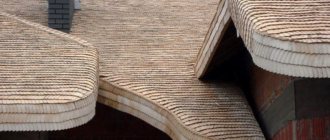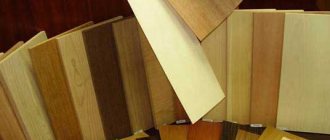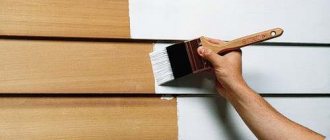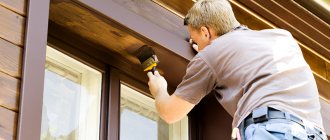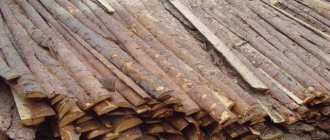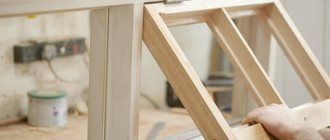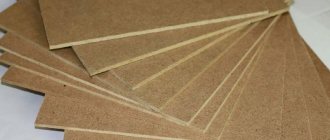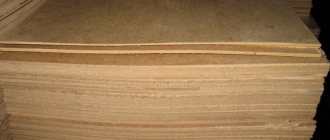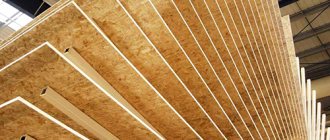Fiberboards have been used in construction for over a hundred years. The production of fiberboard is low-cost, and the material is durable and environmentally friendly. The scope of use of fiberboard panels is varied, but in order for the quality of the work performed to be satisfactory, it is necessary to know all the features of the subtypes of this building material and the nuances of its use.
Fiberboard with the highest density readings is endowed with high-level structural features. F-300 grade slabs can also be used as a sound-absorbing and heat-insulating material.
Permanent foundation formwork
The construction of buildings begins with the construction of monolithic structures, for which concrete is traditionally used as the main material. However, the production of permanent formwork using fiberboard panels not only simplifies the production process, but also significantly saves money.
Stages of manufacturing formwork using cement bonded products:
- After preparing the trenches, a cement-sand cushion is laid, after which fiberboard panels are installed on it in two rows;
- The gap between the panels is filled with reinforcement;
- The fiberboard is secured at the top with wooden blocks. Nails are used as fasteners;
- Concrete is poured inside and compacted layer by layer;
- The external walls of the manufactured formwork are covered with a waterproofing compound.
When using fiberboards, further work can be carried out in about a month.
Insulation of floors
Fiberboard sheets provide optimal protection against sound, impact and airborne noise. Therefore, they are often used as a subfloor followed by laying laminate, linoleum, and tiles.
Stages of floor installation:
- The concrete base is cleaned of dust and dirt;
- Fiberboard panels are laid on the prepared base;
- The joints are covered with cement;
- A cement-sand screed up to 5 mm thick is made on top;
- After strengthening the screed, the floor covering is laid.
The finishing base made of fiberboard does not creak, its quality characteristics do not change under the influence of moisture, and insects do not grow in the slabs.
Insulation of external and internal walls
Wall finishing with fiberboard panels is most often carried out from the inside of the premises.
Insulation of internal walls involves the following work:
- The walls are prepared - cleaned of debris and dust;
- A special glue is applied to the base, onto which the fiberboard panels are attached;
- Additionally, the slabs are reinforced with dowels;
- Insulated walls are plastered;
- After the plaster has dried, the finishing can be done.
When insulating external walls, the lathing is first made, and the facade is plastered with compounds containing moisture-resistant components.
Roof insulation
When constructing the roof of buildings, fiberboard slabs make it possible to achieve additional thermal insulation and at the same time prepare the surface for laying roofing materials. The fire resistance of fiberboard allows some roofing materials to be fused using heat, including open fire.
Fiberboard can be used for roofing if the height of buildings does not exceed 9 floors. The use of fiberboard products facilitates the installation of the roof, since this material is quite light, and it can be laid on the roof regardless of the time of year.
Fiberboard panels
Fiberboard (fiberboard) is a hard and dense material, the creation of which uses two main components:
- base made of wood fiber (wood “wool”). This material makes up approximately 60% of the total material volume
- Portland cement, or rather a mixture of Portland cement and water. It is a strengthening and structure-forming component and occupies 40% of the volume
- another 0.5% of the total volume is occupied by a special substance - a mineralizer. They process the wood-fiber filler before adding the strengthening cement mixture.
Price
The price of fiberboard depends on the size of the slabs, thickness, decorativeness, percentage in the cement composition. The lower limit is 200 rubles. Maximum - 1100 per slab. This is what they ask for for multi-layer fiberboard of maximum width. If fiber cast blocks are purchased, the price is set per cubic meter. It usually costs about 2500 rubles. For some manufacturers, the price is negotiable and partly depends on the volume of purchase. You can also purchase used fiberboard. In this case, the cost of a standard stove starts from 50 rubles.
Classification
Fiberboards are classified according to their average dry density. This classification indicator is implemented by assigning the appropriate grade to the slabs. On the Russian construction market you can purchase fiberboard boards of three main brands:
- F-300 - average density 260-350 kg/m3
- F-400 - average density 350-450 kg/m3
- F-500 - average density 450-500 kg/m3.
Other physical and mechanical properties of fiberboard:
- moisture level per unit mass is 20%
- The thermal conductivity level is 0.08-0.1 W/(mK)
- water absorption per unit mass reaches 35-40%
- elasticity during bending reaches E = 300-500 MPa = 3000-5000 kgf/cm2
- the average bending strength indicator is 0.5-1.3 MPa.
Selection of performers
No matter how good the suppliers and the quality of the material, everything can be ruined by unskilled installation. Since I already had experience working with bad employees, I wanted the interior decoration to be done:
- carefully;
- in compliance with all additional requirements;
- on time;
- without exceeding the budget.
Since the scope of our main activity is far from construction or installation work, we once again looked for performers on the exchange of one of the construction portals. Having described in detail the required work, indicating the location of our house and living conditions, we began to wait for responses. Since the order implied a complete rough finishing of the house and allowed us to earn money, we received about ten responses. After reading the reviews and reviewing the portfolio, we invited representatives of three teams “to the site.” For the first two, the price for work after the inspection changed significantly upward.
Knowing from experience that this happens often and the contractors “intimidate” the customer with complex terms and non-existent elements of the work, we did not continue negotiations with these workers. The latter turned out to be visitors from another region, and their appetites turned out to be more modest. The price did not change; during the inspection, they were interested not so much in the price as in the technical aspects and our wishes. Having discussed the start date for work, we ordered Greenboard for the start day.
Using fiberboard
Fiberboard has found its greatest use in the creation of permanent formwork for monolithic house construction, for example, in the process of constructing private houses of low and high storeys, as well as for reconstruction or repair work. The use of permanent formwork made of fiber boards can be called the simplest, fastest and most economical method of constructing buildings. When using fiberboard boards, no lifting equipment is needed. The standard dimensions of the slabs and low weight made the material high-tech in the construction process. Fiberboard boards are processed similarly to wood. To create curved, complex-shaped structures, slabs are cut. When using fiberboard as permanent formwork, specialists reduce construction time and labor costs by almost half.
Fiberboard houses can be built at fairly low air temperatures. The high thermal insulation rates of this material make it possible to reduce the cost of continuous heating of concrete, as well as to pour concrete on an entire floor of a building in winter.
The fiberboard slab has excellent sound insulation properties. For example, using fiberboard in floor construction, experts significantly increase the level of noise insulation, up to approximately 20 dB. The plate acts as an excellent protector against impact and airborne noise. Thanks to the unique properties of fiberboard, it can be used as a base for floor coverings from tiles to linoleum. The finishing coating will not creak, rot or be damaged by moisture.
The high level of moisture resistance of fiberboard boards makes it possible to use it even in damp rooms with a humidity level of up to 75%. They are also suitable for creating frameless interior partitions.
Fiberboard is used for thermal protection of buildings and structures. If you use it for two- or three-layer options together with polystyrene foam or mineral wool boards, the thermal resistance of such a fence increases significantly.
The use of fiberboard slabs to construct the roof guarantees the preparation of the surface for roofing materials, as well as complete thermal and sound insulation of the roof. Fiberboard is used for reconstruction work in flat roofs of 5-9 storey buildings. The increased fire resistance of the material allows roofers to fuse rolled materials onto the slab using open fire. In addition, the slabs are easy to install; they can be installed under a soft roof regardless of the time of year.
Reviews from forums
Real reviews from residents and users of greenboard sip fiberboard panels can be found on specialized forums.
The only advantage of GB is in fire-fighting properties, and maybe also in terms of ecology, but otherwise it loses to OSB. Heavier, fragile, takes water no worse than OSB. The edge is denser than the sheet itself, so nails hit the thick panel with air pressure poorly. In general, working with OSB is much more convenient.
GB SIP panels
Why are we looking for real reviews? Are you afraid to conduct experiments at your own construction site? SIP panels with OSB are a proven option in hundreds of thousands of homes in Russia and abroad, and the problems are all already known. The situation is such that very few people have built houses from fiberboard, and this is the only way you will make a decision, which, in principle, is not logical.
The construction market shows us that they can build no matter what material, what quality it is, where it will be used, where the raw materials come from and where what they sold was produced. Ultimately, everything is determined by price and profit. The other side of the coin is that no one wants to accept new products on the market; it is convenient to work with what is popular and does not require advertising. No one wants to invest in a little-known and unpromoted product. But here we must understand the difference in price, whether it is justified in the end, looking at the final cost of the entire house. And the price difference is not that significant. Especially if you spread it over the entire cost of the house. And as a rule, people choose an option other than formaldehyde components and choose a time-tested solution.
Advantages and disadvantages
The main advantages of fiberboard include:
- increased level of fire resistance
- it is a fire-resistant building material
- high level of moisture resistance of modern fiberboard boards
- increased resistance to biological agents
- rather low level of thermal conductivity (thermal conductivity coefficient: 0.08…0.1 W/m K)
- high sound insulation rates
- long period of operation (50 - 60 years)
- high bending strength. Fiberboard is used to create interior partitions
- small mass
- ease of processing. Fiberboard is easy to cut and process. Nails are driven into it well and can be plastered.
- speed of installation
- low price.
Houses made of fiberboard have the following disadvantages:
- destruction during prolonged exposure to temperature and humidity conditions of use, therefore, the thermal insulation parameters are reduced. Annual cycles of freezing and thawing lead to negative consequences over time
- if the manufacturer does not follow the production technology and skimps on something, the material will be susceptible to fungal attack. Always ask the seller for a quality certificate.
Supplier selection
Since at the time of ordering there was no manufacturer’s plant nearby, in order not to spend money on delivery, it was necessary to buy the entire volume of material at one time. The conditions for intermediaries are approximately the same. It turned out that if the price for the entire volume was slightly lower, then delivery was slightly more expensive. Our interior decoration of the house with Greenboard was planned for the middle of winter, and due to heavy snowfalls, not all cars could drive to our site. Therefore, we searched according to this principle.
Having sent out several commercial proposals, we received the necessary information. It included: the price of the material, cost and delivery time, availability of the required sizes. For the sake of appearance, having lowered the price a little, we decided on the place of purchase and began looking for builders to carry out installation work.
Fiberboard sip panels
Today, an innovative product occupies a worthy place in the construction market: a SIP sandwich panel using fiberboard boards called Green Board. The panel has three layers:
- one layer of polyurethane foam insulation
- two fiberboard boards.
Such panels are used in the process of creating internal and external walls, stairs, partitions, as well as load-bearing structures. In addition, such material is quite in demand in the construction of cottages, bathhouses, garages, extensions and gazebos, attic extensions in finished buildings made of wood, brick, and concrete.
Such sip panels are environmentally friendly and safe; they are also called “improved wood”. Moreover, the cost of such a building is almost no different from using SIP panels with OSB, but the durability will be higher.
GREEN BOARD fiberboards as part of a sip panel provide the following advantages:
- complete environmental friendliness, which is guaranteed by the absence of toxic compounds in the manufacturing process of GREEN BOARD
- increase in the service life of the entire building structure due to the increased level of durability of GB-3 slabs, which reaches over 100 years. Exceptional innovative technologies enable the material to increase its mechanical properties throughout the entire period of operation.
- GB-3 slabs have fire safety class G1, which is assigned to low-flammability materials. As a result, the overall fire safety of the building increases. Note that the OSB board belongs to class G4, which is assigned to highly flammable materials
- the use of GREEN BOARD fiberboard in SIP panels increases the level of ventilation of the entire building. This indicator is similar to wooden buildings. Fiberboard boards are distinguished by a special system for regulating indoor humidity
- improving the biological resistance of the building. The material from which GB-3 slabs are made, even in humid climates, does not rot, therefore, fungi, pathogenic bacteria, rodents and insects will not multiply there.
GREEN BOARD fiberboard boards in accordance with GOST 8928 are created by pressing a mixture of specially prepared wood-wool chips in accordance with GOST 5244. Chip parameters:
- length 400-500 mm
- width 4-7 mm
- thickness 0.25-0.5 mm.
Portland cement of a grade of at least 400 according to GOST 10178 is added to the shavings, as well as chemical additives such as calcium chloride, liquid glass, lime, aluminum sulfate and water.
Fire safety
No harmful phenolic resins are used in the production of FP. This material meets all environmental requirements. Fiberboard belongs to the group of fireproof materials, class:
- G1;
- IN 1;
- T1;
- D1;
- RP1.
Burn Resistance
These materials do not emit toxic substances, are completely fireproof, never ignite, and do not emit acrid smoke.
Fibrolite is considered a highly flammable material. For example, if a slab of similar thickness is attached to a concrete floor reinforced with metal, 50 mm thick, the fire resistance of the floor will increase from 30 minutes to three hours.
US government agencies provide the following fire spread indicators:
| Material or type of wood | Flame Spread Rating | Flame-Spread class |
| Fiberboard siding panels | <200 | III |
| PA wood structural panels (including APA 303 sidings such as T1-11) | 76-200 | III |
| Brick | 0 | I |
| Cedar, western red | 69 | II |
| Fibreboard, medium density | 167 | III |
| Drywall | 10-15 | I |
| Fiber cement exterior materials | 0 | I |
| Inorganic reinforced cement board (such as asbestos cement board) | 0 | I |
| Masonite | <200 | III |
| Chipboard | 116-178 | III |
| Plywood, pine | 120–140 | III |
Information on design requirements, flame spread indicators
Installation technology
Approaches to installing the material vary depending on the target structure. In most cases, insulation finishing requires the organization of sheathing for installation. As a rule, this is a wooden frame vertically fixed to the wall, in a niche of which specialized insulators are placed, and fiberboard slabs are fixed from the outside as a protective shell. For installation, brackets, mounting brackets, clamping devices, screws and screws are used. In the case of roofing, the sheet will be laid under the insulating “pie”, and in wall construction – on the outside. In interfloor ceilings, fiberboard is laid on both sides and clamped with reinforcing strips.
Material cost
Boards are usually sold with payment per piece (for 1 sheet), and specific price lists depend on the structure, parameters and operational features. For example, structural fiberboard is considered the most expensive. The average sizes and prices for this material look like this: 10x600x3000 mm for 400-500 rubles. and 18x600x3000 for 1000-1200 rubles. These are high-density sheets with several layers. Single-layer slabs with low density and large delivery formats rarely cost more than 600-700 rubles.
Performance properties
Thanks to various special additives, as well as changing drying and crimping parameters, it is possible to obtain a material with a certain set of technical and operational qualities. At the basic level, fiberboard boards are endowed with the following properties:
- Ecological cleanliness. Despite the use of synthetic components as a binder, fiberboard does not emit substances harmful or hazardous to health at all stages of use.
- Durability. It is generally accepted that wood-based materials, in principle, do not have sufficient strength to be used in capital construction. Nevertheless, cement additives and well-thought-out special formulations of the adhesive component increase the service life of the slab to the level of reinforced concrete.
- Fire resistance. The material is low-flammable and does not support combustion. In some modifications, the smoke-forming ability is reduced to a minimum.
- Biological security. Unlike many other panels with a natural base, fiberboard is not subject to destruction processes from mold, fungi, insects, etc.
General impression
More than a year has passed since the finishing was completed. There is no heating yet, but there is a consistently comfortable atmosphere in the house. In winter there is no burning frost, and in summer it is cool and fresh. There is absolutely no foreign smell from Greenboard.
Since the walls were covered with 22 mm thick slabs, you can safely hammer a nail into any place, and if you use butterflies for drywall, you can hang heavy objects. Spots inherent in the structure of the panel can be easily painted over with water-based paint, we found this out when we started priming the walls for liquid wallpaper.
About 135,000 rubles were spent on material and delivery at winter 2022 prices. The overall impression of the material is good: strong, solid and environmentally friendly. We were pleased with the choice.
The house has a total area of about 160 square meters. The wall area is about 500 square meters, 250 sheets were purchased.
Finishing works
The brigade arrived exactly on time. Work began almost immediately. While the slabs were moving, one of the performers began installing the sheathing for the ventilation gap.
It turned out that due to the fact that the frame posts are made from lumber with natural moisture content, they have different thicknesses. For this reason, the sheathing did not lie flat. It was necessary to level it using improvised means, and a separate person was allocated for this work, who performed only this work throughout the entire period of finishing.
The greenboard was delivered late in the evening. The crew unloaded it safely and began installation. The slabs had to be screwed, leaving a technical gap of about 2-3 mm. And in order for the final finish to lie evenly and to prevent foreign debris from becoming clogged, the cracks had to be filled with silicone sealant.
Our main mistake during this period was that we decided to hem the ceilings along with the walls. The builders did everything correctly. The rough ceiling turned out beautiful and smooth, but later we were unable to find a solution to how to make smooth ceilings on a budget.
The cost of puttying and painting was very expensive, and since the house has a wooden frame that can move a little due to seasonal temperature fluctuations, there would be no guarantee that the puttyed and painted walls would not crack. Ultimately, suspended ceilings were installed.
The interior finishing work lasted about a month. During this time, the leveling sheathing was installed, the walls and ceilings were sheathed, and the seams with technological gaps were coated with sealant. For safety reasons, we placed boards in the form of boards for the cornices above the windows, and for heating radiators under the windows.
It is worth noting that despite the sharply negative air temperature, which reached -30C, the house maintained a positive temperature, comfortable for work, thanks to the use of only a small heat gun. What I didn’t like was that the slabs were not the same in width and because of this, differences formed in some places of the seams that needed to be leveled before painting.
